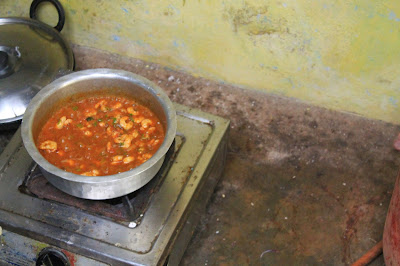I waited patiently while he wrapped the curio in an old piece of paper. And then he looked under the counter, inside a box, asked his neighbouring stall owner and finally found what he was looking for. Fishing out a polythene bag he dropped my ceramic memorabilia into it.
" Thank you, but I'll not need the plastic. In any case these will travel safely in the suitcase" I said returning the offensive thing.
He gaped at me for a few seconds before blurting out, " I am sorry, I thought you were Indian..."
" But I am! "
It was my turn to look confused.
" Well...you see...Oh! Never mind! "
Then curiosity got the better of him.
" All Indian tourists ask for this. Why don't you want it?"
It wasn't a flattering observation but he wasn't wrong. We have been guilty of walking out of shops, plastic bags dangling with the goodies because it was convenient. As many bags as the number of shops visited.
Littered streets and loud crowds. Ugly concrete structures pierce out of hill slopes and barricade the sea side. In all the cacophony and visual chaos, the charm and the very identity of a place is hammered, built, boarded and gagged into a homogenous backdrop. It is sad to see Mussorie, Shimla, Darjeeling, Goa, Kovalam remain just a heavily made up belle desperately trying to peddle her charms. Their fault? They were stretching out their limbs, allowing the sun rays to kiss the hill tops, slide down their valleys, letting the lapping waves send them into a blissful slumber in the warm sand. Until the roving eyes discovered them.
Respect In A Relationship
There is a wide chasm between lust and love. It is the absence of respect in the former that reduces any relationship to cinders.
Travel is a relationship forged in many ways - with the journey, with the place, with the people. But most importantly, it is a relationship with the self in the ways it nudges the many facets of the self and the many thoughts that bubble up.
 A responsible traveller is like the seeker who will tip toe around the bend and watch the place unravel and 'be'.
A responsible traveller is like the seeker who will tip toe around the bend and watch the place unravel and 'be'. There is no demand to 'show' it's wares or to please all and sundry. A responsible traveller will accept it the way it is and not expect it to change with a plush hotel here or a night club there; authentic North Indian food in Rameshwaram or the perfect
sambhar in Pahalgam. Respect for the local people, their lives, their culture and their cuisine is the key to a traveller's enrichment. It is like being nourished with healthy seasonal food rather than the quick titillation with fast food. While the latter will have you hungry again filling you with empty calories, the former will have you satiated for a long long time, working to heal and fill your body with nutrients.
We have travelled. And quite a bit. With each journey we have grown as individuals and probably turned a wee bit wiser. Where once we were happy to take in the sights and taste of a new place, thumping our backs for having ticked off yet another name from our travel list; that list is of little consequence now. We would rather let the place, any place, work its way into us and unfold it's charm in the many unique experiences it can steep us in.
Public Transport
Having driven down the Indian West Coast once before, t
he best way to do this, we have discovered, is to hop onto a public transport. The ride from Mumbai to Kudal on
Konkan Railways, through the many tunnels in the Western Ghats and chugging by the red roofed hamlets, has been one of the best so far. On another trip, an impulsive change of plans before reaching Amsterdam took us on a delightful cycling spree in Kinderdyke with the ancient wind mills watching us indulgently. It was a metro ride from the Rotterdam railway station to Zuidplein, from where we boarded a bus to
Kinderdijk through the Dutch countryside. Chatting with the Korean student, lumbering down with us in the bus, who was keen on exploring the Northern Italy rather than the touristy South Italy; watching a senior couple cycle their way around the place; we promised ourselves to grow old exploring the world. It is these little twists in the journey that add that zing to a travel experience making them memorable.
Walk Along
Walking around Malvan, a corner of a nondescript fishing village opened up a sliver of the Arabian sea with fishing boats passing by, reflecting the sunrays off it's white hull. Sitting down there my open book lay idle it's pages ruffling in the gentle sea breeze, the mind wandering here and there, bouncing off the waves. Or the time when the ears picked up the faint plaintive melody, carried over the cold barren fields near the
Hemis Gompa in Ladakh while we stamped our feet to keep ourselves warm in the subzero temperature. We have not barged but quietly
let ourselves into these different worlds that hold so much of truth, beauty, and if you listen carefully, a whole lot of wisdom.
Next time you plan a trip, remember to keep some time aside for walking. If you are an early riser, this is the best time to 'feel' a place as it quietly emerges and sets the canvas for the day. You may find an interesting nook to explore which could have easily been missed in the crowd. Walk along the shore in Havelock, jump around the rocks or spend some time lying on a low branch looking out into the sea. Walk into park in Thiruvanantapuram and listen to a carnatic recital in the jasmine scented evening. Stop by an autumn field in
Dhemaji and watch them reap the golden harvest in a Bodo village. There could be a small kiosk waiting with some steaming appams in Gudalur. What a pity it would be if you missed bringing all these little memories home!
Adopting Homestays
Homestays is what we look for now, for it offers a slice of local life that no other hotel can ever replicate. Allowing an existing accomodation to take in guests, lies easy on the conscience in the fact that additional structures were not built to add to the burden. Come to think of it. In fact,
the existing hospitality conglomerates could take up homestays as viable and sustainable projects. Places that are opening up to the travel circuit, the conglomerates could adopt a few homes or a village, upgrade and make comfortable to accomodate guests. An extra income for the local people, an exotic experience for the traveller and a worthy CSR for the hospitality chain! Best of all, those ugly structures are restrained from popping up.
While the onus lies on the traveller to choose and plan so as not to disturb the existing social, ecological and cultural balance,
the service providers too need to be sensitized on this important aspect of travel. On our trip to Malvan, we had booked ourselves into a homestay in the middle of a fishing village. While we had the entire Malvani home to ourselves right on the beach, we were treated to some of the sumptious local cuisine by Vishal, the caretaker, and his mother. On one instance when we did try out an eating joint in the town, one that came with rave reviews, our final verdict was that nothing could beat the home cooked food. A famous restaurant chain of Mumbai popular for its Malvani cuisine, came nowhere close to the lady's
sol kadhi, to speak of basics. These words immediately pepped up Vishal's mother who was pretty let down after we had ventured out.
" Why do you spend so much money on that outside food? I give you freshly cooked meal here at home..."
And that was the end of the matter. One such finger licking meal, had me traipsing to her kitchen to figure out what she did to the ingredients that had us asking for more. So with live demo, the spices that went into that unique touch, the exact way to mince the condiments, I came back armed with a couple of authentic Malvani recipes.
Lazy evening conversations with Vishal revealed that the people in the town have been trained in their existing skills to participate organically in the tourism sector. In addition to fishing which is the main occupation, they earn extra by providing services to the visitors. That night we slurped down some more of the delicious Surmai curry,
happy to be contributing a drop into the sustainable ecosystem.
Encouraging Local Craft
Part of this ecosystem is the local handicraft that tell the stories of its people. Hordes of tourists have been seen lapping up woollens and garments in the famous hill stations not realising that these have arrived from the plains travelling up the same route as they did, from places like Ludhiana. And worse now, those plastic hats and toys that come from China. A bit of research before the trip will tell, the availability of raw materials of a place and the things made out of them. A Toda embroidered product from Ooty, the little black wooden men from the Andamans, the brass lamps from Thrissur or the robust hand knitted yak wool socks from Leh will keep their hearths warm and the conversations going in your homes.


Down the years, we may want to return to some of these places to rekindle the relationship and go back feeling nourished. To find them empty, bereft of a soul whimpering under all that jazz would be tragic. The worst we could do is to raise clones while the best we could ensure is to let each destination breathe and grow as unique individuals. Little conscious efforts is the beginning of responsible travelling. It doesn't take much time to develop it as a habit. Before you walk out of the hotel room, er... did you drop your bath towel on the floor after the first shower? Or use a fresh plate for your buffet meal after every sampling?
There is a whole wide world waiting to be loved. All it needs is to be nurtured with responsible travelling.








































